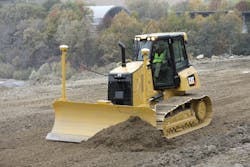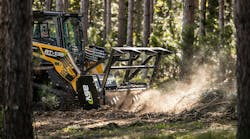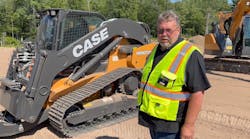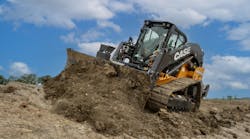Deadlines can adversely affect decision making. A deadline can lead to shortcuts that result in improper machine setup and poor choices in operating techniques. In short, in attempting to meet a job closing date, you sacrifice long-term profitability in exchange for saving a little time today. That isn’t a cost effective way to manage tracked machines. With some advance thought and a little preparation, you can improve undercarriage wear life by matching the correct undercarriage to the job site, which in turn lowers owning and operating costs. And as a result, your tracked machines operate more efficiently.
Tim Nenne, undercarriage market professional for Caterpillar, helps customers extend undercarriage life. One suggestion tops his list:
“The biggest single step a customer can take to improve undercarriage life is to maintain track tension at the correct specification, whether it’s a track-type tractor, track loader, or hydraulic excavator,” he said. An improperly adjusted undercarriage shortens the life of components.
The same machine setup will not necessarily work across different applications. You need to prepare the machine for the underfoot conditions, temperature, terrain and type of work.
“It’s worth the time to properly set up the machine for the application because it will give you the lowest owning and operating cost,” Nenne says. A crawler dozer can benefit from a different machine balance when it is dozing than if it’s ripping, or the underfoot conditions may require a different type of shoe.
Operator habits are equally important in controlling undercarriage wear, Nenne says. His top tip for operation: “When running a track-type machine, your operating costs will go down if you reduce the number of unproductive miles.” He suggests undercarriage wear also be measured in the number of miles traveled and not just in operating hours. Newer machines monitor travel distance in both forward and reverse. The second most important operating tip for tracked machines is to avoid high speeds to reduce wear on internal and external undercarriage components. For hydraulic excavators, Nenne’s No. 1 recommendation is to design the worksite so the operator is digging over the front idlers, if at all possible, to minimize structural stress.
Most crawler dozers come from the factory with sealed and lubricated track, commonly called SALT. Today, a smaller number of customers are doing pin and bushing turns on small to medium dozers because of increased labor costs. This holds true unless the machine is operating in an abrasive application. Manufacturers now have been able to lengthen bushing and sprocket life to the point where turns are less of a necessity in order to obtain the most life out of a link-roller system. Nenne recommends wet bushing turns on dozers. During a turn, the bushing is rotated 180 degrees and the pin is flipped end-for-end. This provides a new wear surface and resets the track pitch, which then allows the customer to get the most life out of the link-roller system.
SALT has been installed for quite some time on large machines to get maximum life from the more expensive link-roller system. There is still good value in performing a bushing turn in large machines in order to maximize the life of the link-roller system. Internal wear is not a significant factor on these machines, so turns are for external wear. Where ambient temperatures are high, dry track is used with no urethane seals or lubricant, but typically there are special high-temperature lubricants in the roller system.
A hydraulic excavator undercarriage may get additional value by doing a pin and bushing turn. In some cases, excavator shoes, rollers and idlers can be reused for a second link assembly. All this will save money, but only with proper undercarriage management.
Most manufacturers now produce small and medium excavators with greased track for improved internal wear and quieter operation. But you still must manage greased track because internal wear exceeds external wear in many applications. The grease does not remain in place for an extended period of time like oil does in SALT. To calculate internal wear on greased track, determine the pitch length across four joints, measuring from the left side of the first pin to the left side of the fourth pin. Match that measurement against the manufacturer specifications to gauge the amount of wear. When it’s 100 percent worn, you can perform a pin and bushing turn to reset the wear back to zero if you judge the turn to be economically feasible. Dry turns may be appropriate for excavator track because they don’t move as much as dozers.
Nenne, with more than 20 years of undercarriage experience in research, testing and field work, advises to compare costs beforehand. “In order to get the best economical life from a link-roller system, you should weigh the cost of turning the pins and bushings against running to destruction.”
Some larger hydraulic excavators use a SALT seal that keeps grease in place for a longer period of time. That allows the large machines to run longer without internal wear and prolongs the service point and reduces overall undercarriage costs.
The goal is to get the most life from an undercarriage. To do that, Nenne has two words: “Manage it.” Make sure the machine is set up properly for the application and the operator is practicing the correct techniques.
See our How To guide for specific tips.
--Tim Nenne handles undercarriage customer and dealer support for Caterpillar.





